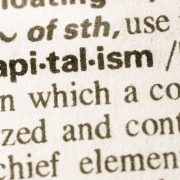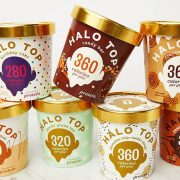I have written much about the extraordinary increase in living standards1 that Americans have enjoyed over the last century, and especially in the last forty years. For me, one of the best indicators of this incredible progress can be seen in the evolution of the grocery store. A great treatment of this evolution is food writer Michael Ruhlman’s recent book Grocery.
The grocery store is in many ways a metaphor for the increase in American living standards experienced by both rich and poor. Those of us who remember the 1970s have perhaps the best sense of this evolution, as we can remember what even good grocery stores were like back then. Stores were generally small, not well lit, not always clean, limited in the variety of goods they stocked (especially fresh produce), and lacking in the prepared foods we take for granted at most grocery stores today.
The 21st century American grocery store, by contrast, is a marvel of higher quality, lower cost, and expanded variety. There is simply no comparison between the quality of the produce, meats, and bread available at even a large middle-market chain like Kroger today and what was available anywhere in the 1970s. Measured in terms of labor hours required for purchase, food has generally never been cheaper. We see that today, as poverty in America is far more likely to be associated with obesity than with being underweight.
The growth in the variety of products available in the market in general is an excellent, if underappreciated, indicator of economic progress, reflecting as it does the Smithian insight that the division of labor is limited by the extent of the market. With growth comes more wealth and larger markets that enable producers to have a market for more finely differentiated products.
An example from the evolution of the grocery store illustrates this point. In the 1970s, there were maybe five or six kinds of potato chips (regular, barbecue, sour cream and onion, ruffled, tortilla chips, and the stuff in the can). Today, the typical grocery store has a potato chip aisle that offers dozens of differentiated products along numerous dimensions. This increase in variety allows consumers to satisfy their preferences more precisely, increasing their subjective well-being. You want your gluten-free, lactose-free chocolate chip cookies? You can probably find them. You want your throwback taco-flavored Doritos? They’re there. The expansion of variety in the typical grocery store has dramatically increased the subjective well-being of American consumers in ways that macroeconomic measures like GDP cannot capture.
The growth in variety can be seen not only in, but across grocery stores. The grocery market was once largely characterized by a number of regional chains (Kroger and Publix, etc.) along with a mix of very local chains and mom-and-pop stores. Regional chains were similar in their sizes and offerings. However, in the last twenty-five years or so, the variety of stores to choose from has dramatically increased. The market has seen the entry of a variety of higher-end large stores, such as Wegman’s, but also higher-end stores of more modest size such as Whole Foods and Trader Joe’s. More recently, stores like Fresh Thyme and Fresh Market have become players in this market, with similar high-end and environmentally responsible products.
At the other end of the spectrum are stores like Aldi’s, stocking few name brands and trying to capitalize on cheap prices for staple goods. Then there are the big box stores such as Walmart and Target, and regional ones like Meijer. These super stores do not have the grocery selection of even most chain stores like Kroger, but offer the low prices consumers have come to expect plus the convenience of one-stop shopping. There are also warehouse stores like Sam’s Club, Costco, BJ’s, and farmers ‘ markets, artisanal butcher shops, and a whole range of other specialty stores. When we look broadly enough, we also need to include the dollar stores, drug stores, and convenience stores, all of which also compete in the grocery market. And let us not forget Amazon’s purchase of Whole Foods, which might be a big game changer.
The empirical data on where Americans buy their groceries5 are fascinating in this regard. The top five sellers of groceries in the United States in 2016 by market share were:
- 1. Walmart/Sam’s Club: 21.4%
- 2. Kroger: 10.2%
- 3. Albertson’s: 5.2%
- 4. Costco: 4.2%
- 5. CVS: 3.9%
Also in the top ten are Target (2.7%) and Walgreens (2.4%). Dollar Tree and Dollar General are ranked 11th and 12th, respectively, while Whole Foods is at 13th and Trader Joe’s is 18th with 1.0%. (One note to consider—a good deal of the share of the warehouse stores is likely business, not household, purchases, so we might view those numbers carefully.) The presence of CVS and Walgreens might be surprising. CVS sells more groceries than Publix, Target, H-E-B, Whole Foods, Aldi, and Trader Joe’s, and Walgreens sells as much as Whole Foods and Trader Joe’s combined.
More, better, fresher
I have already suggested the explanation for increasing in-store variety and quality: the generalized increase in wealth has given households the means to purchase more and better products and created larger markets for more specialized products. The gains in technology and food science, along with the widespread reduction in transaction and transportation costs, have enabled producers to increase quality, get better information on what consumers want, and ship those products to stores more quickly, more safely, and all year round. We take for granted the ability to get almost any fruit or vegetable year-round these days, when that was not possible even as recently as the 1970s or ’80s. Some of that is due to food science enabling us to grow things indoors and ship them more cheaply from far away, but it’s also due to the growth of global trade agreements reducing the transaction costs of getting produce from places where it is in season.
Similar factors are at work in explaining the increase in the variety of grocery stores, as more Americans can afford higher end produce and meats, and falling costs have made it possible to supply them. They might wish to get their basics at the warehouse or Aldi, or delivered by Amazon, as quality differences are fewer. This fragmentation of the grocery market parallels that of other markets (e.g., recorded music) as technology and falling transaction costs make thinner markets more profitable and thereby enable people to obtain more precise matches for their preferences.
But what explains the rise of the drug stores? The same factors that explain grocery purchases at drug stores explain, at least partially, the success of Target and Walmart and the warehouse clubs at selling groceries. What they all have in common is enabling shoppers to conserve on the most precious resource of all: their time. As Americans have become wealthier, our time has become more valuable. Higher incomes also mean that our time spent doing other things has a higher opportunity cost. And the generalized increase in wealth means that we have money, and perhaps time, to spend on other things that we value highly, including consuming leisure and being more engaged in our children’s activities. More women, especially those with young children, entering the workforce since the 1970s, have accelerated this trend. Time for households to shop, and not just for groceries, is much scarcer than it used to be.
Two other factors help to explain the market share of CVS. First, they have over 10,000 stores, while Kroger has 2,000. Every CVS earns far less in grocery revenue than a single Kroger, but with so many more stores, it is able to have a market share disproportionate to its low per-store sales. Many CVS stores are also located in very walkable urban areas. In those neighborhoods, the convenience of CVS is understandably irresistible when walking home from work or needing a quick item last minute, even given the higher grocery prices at CVS compared to Kroger. They have become a version of the neighborhood bodega. Even a suburbanite driving home from work who just needs milk and bread might find the closer parking, smaller store, and shorter lines at CVS to be worth the higher prices.
The same factors that explain grocery purchases at drug stores also explains, at least partially, the success of big box and warehouse stores in this market. The opportunity to engage in “while you’re there” grocery shopping at drug and big box stores is really valuable to time-constrained people, like when you need some clothing for the kids, or some school supplies or any of the other items those stores carry, including prescriptions! Similarly, the warehouse stores are time savers because one trip can stock you up on dry goods and family-sized food packages for longer, reducing the number of shopping trips you make. Warehouse stores also, to the extent they cut down on the number of automobile trips, are environmentally friendly.
We want to spend less time buying groceries. Technology and lower transaction costs enable us to do that even while shopping at more places than we used to. At the same time, our higher incomes enable us to spend more on both groceries and eating out if we so desire. In 2016, retail sales at restaurants exceeded those at grocery stores for the first time since such data have been tracked, even as both continue to increase.6 Some forms of eating out are time savers, but others are not. With Census data indicating significant growth in households earning above $100,000 per year over the last forty years, it is not surprising that we have seen growth in full-service fine-dining restaurants alongside the growth in fast and fast-casual options. It’s also not surprising that some of our increased wealth is being used to engage in higher-quality cooking when we do cook, as the rise of the high-end grocery stores and high-quality ingredient-delivery services indicates. Indeed, sales of cookware increased 50% between 2006 and 2015,7 with higher-end products like cast-iron going up by 300%. Some of this is surely due to the rise of cable cooking channels and celebrity chefs, not to mention Facebook and Instagram, but their existence is itself a consequence of many of the same underlying changes in technology, transaction costs, and the average level of household real income.
The Best Is Yet to Come
The next steps in the evolution of the grocery market may be driven by Amazon’s purchase of Whole Foods. My own prediction parallels Ruhlman’s in Grocery: we’ll see the center of grocery stores shrink, as dry goods come from Amazon or warehouse stores. The perimeter of grocery stores will remain, as produce, meat, baked goods, dairy, frozen foods, and prepared foods will continue to be demanded in increasing quality and variety. A Fresh Market store offers a preview of that future: gorgeous high-end fresh produce and meat/fish, a wide variety of prepared foods and baked goods, excellent beer and wine options, and a limited selection of high-end nutrition-oriented and environmentally responsible dry goods. Most of their products are more expensive than at Kroger, but the quality is much better and the shopping experience is quieter and more cultured.
As I was writing this piece, my local Kroger announced that it is backing out of its plan to build a new 132,000 square foot Kroger Marketplace.8 Instead, it will renovate the existing store, which is half the size, to expand its ability to offer “services like curbside pickup, Scan, Bag, Go and delivery” as ways to up its online game. This move is consistent with both the importance of timesaving and the rise of alternatives for getting many of the goods traditional grocery stores have offered. And while Kroger didn’t say so, the speculation that this is a response to the Amazon purchase of Whole Foods seems reasonable. The future does not lie in larger stores.
I also expect to see the return of specialty butcher stores and bakeries, and the increase in the number and popularity of farmers markets is evidence of that trend. In some ways, this is a return to the past. Before the rise of the supermarket, Americans bought their produce, baked goods, and meats at different places. But now, the quality and variety will be greater, and competition from everything from Amazon, to high-end grocery stores, to warehouse clubs, to big box retailers will ensure that Americans of all income levels have a variety of options to meet their own ability to tradeoff more precisely on the multiple margins of time, quality, convenience, and price.
We already live in a golden age for grocery shopping and food choices, and the future only looks more yummy.













